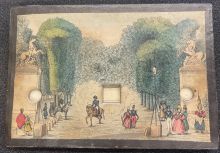Tunnel book depicting a promenade on the Champs-Élysées
Introduction

The University of Pennsylvania’s Kislak Center for Special Collections, Rare Books and Manuscripts possesses a colorful, elaborately detailed tunnel book (a type of pop-up book) from the nineteenth century featuring a three-dimensional layout. This unnamed book, which contains five internal prints with hand-colored etchings and a front and back cover, measures approximately 13 x 19 x 1 cm when closed. It has no author and is cataloged simply as Tunnel book depicting a promenade on the Champs-Élysées. As the catalog title indicates, this tunnel book depicts people walking along the Champs-Élysées, a world-famous avenue in Paris, France.
The date and location of authorship are not provided; however, the book is thought to have been made during the nineteenth century, but not earlier than 1836, as this is the year when the Arc de Triomphe, which is depicted in the book, was completed after being commissioned by Napoleon Bonaparte thirty years prior to celebrate his victories in war.[1] In the Notes section of the library catalog listing, a comparison is made to a similar 1827 tunnel book depicting an unfinished version of the Arc de Triomphe: Optique no. 4 Promenade de Longchamp, ca. 1827. Cf. R. Hyde, Paper peepshows, cat. 24. [2] In fact, many nineteenth century tunnel books may have portrayed similar scenes of the Champs-Élysées, differing in details based on the artist and the year created. Historian Ralph Hyde’s book Paper Peepshows: The Jacqueline and Jonathan Gestetner Collection describes Cat. 24: Optique No. 4 Promenade de Longchamp as depicting “the occasion of the Promenade de Longchamp,” with spectators seated in chairs and looking west toward the Arc de Triomphe, “still lack[ing] its attic storey,” which was added to the monument in 1836. (Hyde book citation)
Due to the popularity of tunnel books in the nineteenth century, it is likely that the Kislak Center tunnel book was created at some point in the mid- to late-1800s, after the monument was completed. There is no evidence of this book being copyrighted or licensed. The book was acquired by Penn in 2016, when it was donated by Alan Maxwell Fern (1930) and Lois Fern (1934).
Background
What is a tunnel book?
When the word “book” comes to mind, most people today tend to think of a physical, hand-held object containing information in a familiar, standard format: printed or hand-written pages (with or without pictures and often made of paper) bound together on one side, with a front and back cover, and usually of a square or rectangular shape. This reflects the layout of many modern bound books, which, due to their design, typically present information in a two-dimensional format. Physical books, however, can take on a wide range of shapes, sizes, and forms, with some having a three-dimensional, interactive design. Over the years, books with three-dimensional pages have been called a variety of names, such as pop-ups, optiques, areaoramas, cosmoramas, peepshows, and tunnel books (Kahn). These books feature images that pop up, fold down, move, rotate, or are arranged in such a way that it provides a three-dimensional effect.
History of Champs-Elysees
History of Tunnel Books
Raree shows and magic cabinets
International expositions and world fairs
Victoria & Albert Museum Collection
There is an extensive collection of tunnel and peepshow books at the Victoria and Albert Museum (V&A) in London, England. More than 350 of these books were gifted to the museum from collectors Jacqueline and Jonathan Gestetner (Kahn). The Gestetner’s had possessed the world’s largest collection of 19th-century peepshow books prior to donating them to the museum, which digitized the books to ensure that they can be viewed by the public without being damaged, as many are very fragile (Daley). The peepshows in this collection feature a wide range of scenes from Victorian life as well as faraway places and famous events. V&A curator Catherine Yvard, as interviewed by The Guardian in 2016, stated that the books in this collection “offer wonderful insights into social history. Considering that most of them would have been made quite cheaply, it is a miracle that so many have survived” (Daley). The collection includes numerous books devoted to the Thames Tunnel and the Crystal Palace in Hyde Park, London (V&A). In addition to 19th century paper tunnel books, the museum has a few solidly built peepshow boxes that are considered to be precursors to the tunnel books. Two of these are 18th century pieces called “perspective views,” created by German engraver Martin Engelbrecht and featuring vocational scenes, such as a painter’s studio and printing workshop (V&A). Additionally, the Gestetner collection contains a piece that is considered one of the oldest tunnel books ever created: a peepshow by H. F. Muller showing a country house and garden, dating back to 1825 (Daley).
References
- ↑ Murray, Lorraine.“Arc de Triomphe.”Encyclopedia Britannica, 24 Mar. 2023, https://www.britannica.com/topic/Arc-de-Triomphe. Accessed 13 April 2023.
- ↑ tunnel Book Depicting a Promenade On the Champs-Élysées [Place not identified: publisher not identified, n183.